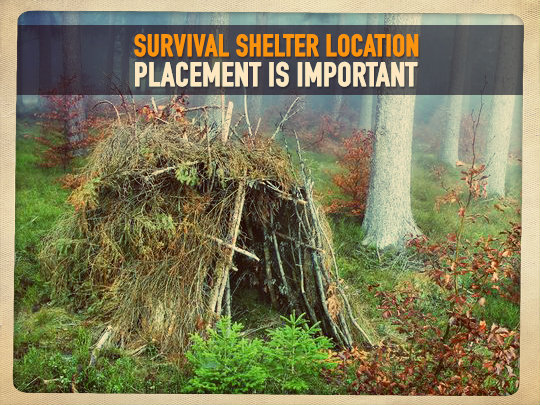
Shelter can mean the difference between life and death in a survival situation, and so the importance of a shelter cannot be stressed enough. However, your shelters’ location is just as important, and it is something that must be carefully considered.
Your shelter will protect you from cold winds, the scorching rays of the sun, from rain, snow, from insects and from predators that prowl the night as well. Mother Nature is unforgiving and she will insist on near perfection when it comes to the location of your shelter.
Is Your Survival Shelter in a Danger Zone?
1.) The term “widow maker” or fool killer is typically associated with logging operations. A widow maker is a broken or detached limb that is caught in the branches of a tree. When loggers using a chainsaw, ax, or crosscut saw, for example, are attempting to bring down a tree, any detached limbs can fall as the tree is felled and strike anyone underneath.
The broken limbs can of course fall at anytime on anyone, and one could fall on you or your shelter. If given a choice, your shelter should not be placed under any large trees that could pose this hazard. Even healthy limbs can break off and fall in high winds, or come down due to heavy snow or ice buildup.
2.) Flash flooding can happen at any time without warning. Heavy rains miles upstream can cause any creek or river to overflow their banks. These could be creeks, or rivers that you may be miles away from that can overflow and create flash flooding where you are. Rapid snow melt can also cause flooding without warning.
Previous flooding will leave evidence, but a lack of evidence does not mean it cannot happen at any time. Study the terrain and look for the high ground. This does not mean you have to climb the highest cliff in the area to perch on top but study the area. Are you in a depression, or down slope from a large outcropping for example, or near a dry wash? Stone outcroppings of any size can act as rain gutters during heavy downpours that may direct water into your camp.
3.) Rockslides, mudslides and avalanches are a danger as well so camping at the foot of any cliff or hill can put you in the danger zone. The debris field at the bottom of any cliff will give you an indication of the dangers.
4.) North and South placement. In cold weather face the opening to the south and of course in hot weather face north to take advantage of Mother Nature’s good nature.
5.) Should you build your shelter as close to a body of water as possible? It depends, lakes and large ponds can act as a defensive barrier against predators four legged and other wise, and in warm weather it will be cooler near large bodies of water due to the evaporative process. You should not camp close to stagnated bodies’ water however, because of reptiles and insects, mosquitoes in particular.
Moving water is noisy so your hearing will be compromised, and you may not hear predators prowling at night. In addition, as stated earlier rivers and streams can overflow their banks while you are sleeping.
Other Considerations
Heat transfer is something that you always need to consider in any survival situation. Heat conducts to cold, a hot mass to a cold mass. In the winter, your body is the hot mass and the cold ground, snow bank and the cold air around you is the cold mass.
Conduction works both ways so in the in the winter you want to contain body heat, in other words prevent it from conducting to the cooler mass. The reverse is true in the summertime. The hot air around you will conduct to the cooler mass, your body, so you need shelter to prevent this from happening. You need protection from the sun.
Even in the summer time you should attempt to make an elevated sleeping platform. As the sun sets infrared radiation will rise toward the cooler atmosphere if there is not a heavy cloud cover.
It will rise from vegetation, rocks, the ground, and from your body, thus cooling you off at night, so having an elevated platform allows for air circulation under your body that will help cool you. This process often times creates ground fog and will cause dew to form on cooled exposed surfaces in the early morning hours.
Natural Shelters
Caves, overhangs, and the depressions made from down trees make ideal shelters. Readymade means less work for you, however some other mammal, or reptile may already have signed a lease on the property, and trying to evict the current tenants could be hazardous to your health.
You cannot rush in, and in some parts of the country or world some very dangerous reptiles or mammals could be snoozing inside. Keep in mind just because the shelter is empty does not mean the occupant is never coming back. They may be out shopping for food, and when they drag the kill back to the cave it is a safe bet that they would not be inclined to share.
The point is be careful when choosing natural shelters because an obvious shelter to you is just as obvious to the creatures that live in the woods year around.